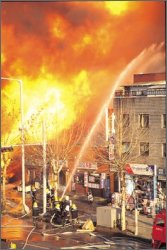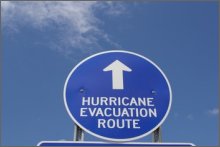If Natural or Terrorist Disaster Occurs, Do You Have a Family Plan? (Download Your FREE Planner Now)
by www.SixWise.com
Widespread disaster, as we know all-too-well, can have multiple
causes: terrorist attacks, chemical, biological and radiation
threats, explosions, nuclear blasts, and of course natural
disasters like the recent devastating hurricanes. When disaster
does strike, most families are swept up in chaos and panic
while trying to determine what step to take next.
|

In case you can't return home, your family should have
a neighborhood meeting place and an out-of-town contact
person to call.
|
But expecting the unexpected and creating a plan of what
to do during a disaster -- long before disaster strikes --
is the best way to keep your family safe.
How to Create Your Family Disaster Plan
The Federal Emergency Management Agency (FEMA), along with
the American Red Cross, suggest following these four steps
to best prepare your family for disaster.
1. Find out what the threats are.
Depending on where you live, certain types of disasters are
more likely to happen. Your local emergency management office,
civil defense office or American Red Cross chapter can tell
you what threats exist in your region, and give you information
to prepare for each.
Once you know the threats, make sure you're familiar with
your town's warning signals. A tornado siren may sound different
from a terrorist attack warning, for instance.
Also be sure to ask about disaster plans at your workplace
and your children's school or day care. Each should have a
predetermined plan in place.
2. Create your family disaster plan.
Have a family meeting, including the children, to discuss
the purpose of the disaster plan, and the most likely reasons
why you may have to use it. Then:
-
Pick two meeting places. One should be right outside
your home (near a familiar tree, for instance) in case
of a fire, etc., and one should be outside of your neighborhood,
in case it's not safe to return home. Make sure everyone
knows the address and phone number of this location.
|

Knowing evacuation routes ahead of time, and being
prepared with a portable Disaster Supplies Kit, will
help you out in an emergency.
|
-
Choose an out-of-state "family contact."
In an emergency, it may be easier to make a long distance
call than one to the affected area. Each family member
should know the name and phone number of the out-of-state
contact, and should call them with their location during
a disaster.
-
Discuss what to do in an evacuation, including
how to take care of your pets.
- Download this
Family Communications Plan. It will help you keep
track of important names, phone numbers, addresses, and
other family information that you'll need during a disaster.
3. Complete this checklist from FEMA and the Red Cross.
-
Post emergency telephone numbers (fire, police, ambulance,
etc.) by phones
-
Teach children how and when to call 911
-
Show each family member how and when to turn off the
water, gas and electricity at the main switches
-
Check if you have adequate insurance coverage
-
Teach each family member how to use the fire extinguisher
and show them where it's kept
-
Install smoke detectors on each level of your home, especially
near bedrooms
-
Conduct a home hazard hunt, looking out for fire hazards,
poisons or other threats
-
Stock emergency supplies and assemble a Disaster Supplies
Kit (see below for what to put in it).
-
Take a Red Cross first aid and CPR class.
-
Determine the best escape routes from your home. Find
two ways out of each room.
-
Find the safe spots in your home for each type of disaster.
4. Practice your plan.
If you go over the plan once and never speak of it again,
chances are you'll forget it. Just like schools conduct periodic
fire and disaster drills, your family should too. Every six
months or so, go over the important information (contact names,
phone numbers, meeting places, etc.) with kids and conduct
fire and emergency evacuation drills in your home.
Also be sure to replenish emergency supplies like water and
food (they'll only last so long before going bad), test and
recharge your fire extinguishers and test (and change the
batteries in) your smoke detectors.
What to Put in a Disaster Supplies Kit
Every family should keep the basics necessary for at least
three days of survival (for each family member and pet) on
hand at all times. The U.S. Department of Homeland Security
recommends including the following items in your kit:
|
Get Your Family Communications
Plan Ready Now!
By downloading the Family Communications Plan from
the U.S. Department of Homeland Security, you can rest
assured that all of your important family information
is collected in one safe place. It has spaces for all
the necessary information, like:
-
Social security numbers and medical information
for each family member
-
Contact information for workplaces, schools, daycare
and other places your family frequents
-
Contact information for doctors, pharmacies, insurance,
veterinarians, etc.
-
Wallet cut-outs for each family member to carry
that list names and numbers of in- and out-of-town
contacts, neighborhood meeting places and more
Download
Your Family
Communications Plan Now!
|
-
Water: Plan on one gallon of water, per person
per day, plus extra for pets
-
Food: Stock at least a three-day supply of non-perishable
food for each family member and pet
-
Battery-powered radio and extra batteries:
To hear emergency instructions and news updates
-
Flashlight and extra batteries
-
First-aid kit
-
Whistle: To signal for help
-
Dust mask or cotton t-shirt: In the event
air is contaminated, you can place it over your nose and
mouth to help filter the air
-
Moist towelettes: For sanitation
-
Wrench or pliers: To turn off utilities
-
Can opener: To open canned foods
-
Plastic sheeting and duct tape: To "seal"
your room by taping windows and other outlets closed if
outside air is contaminated
-
Other family necessities: This could include prescription
medications, infant formula, diapers, important family
documents, etc.
-
Garbage bags and plastic ties: For personal
sanitation
While there's no way to predict when or where disaster may
strike, knowing that your family knows what to do and where
to go, and that you're prepared, will give you peace of mind
that your family will be as safe as possible.
Recommended Reading
Severe Weather:
The Most to Least Fatal & the Key Steps to Save Your Life
Floodwaters
Carry Dangerous Bacteria: What You Should Do if YOU are Ever
Exposed to Bad Bacteria
Sources
U.S.
Department of Homeland Security: Ready America
Federal
Emergency Management Agency
American
Red Cross